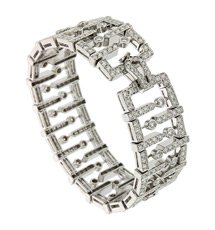The Form of a Ring
 Diamonds are a popular element to engagement rings and wedding bands. They’re admired for their brilliance, durability and symbolism. While the rings themselves get recognition, they’re often overshadowed by jewels. There’s plenty of variety to be had with band designs, including the shapes they take on.
Diamonds are a popular element to engagement rings and wedding bands. They’re admired for their brilliance, durability and symbolism. While the rings themselves get recognition, they’re often overshadowed by jewels. There’s plenty of variety to be had with band designs, including the shapes they take on.
The most common type of band is a circle. This shape is a comfortable fit for the finger and serve as a base for other ring types. Circular bands may have originated as a romantic gesture. The shape goes around and round without end. Love too is constant.
A variation on the circle is to give the shank a bend. These are known as curved or V shaped rings. Some may have more dramatic or subtler arches than others. The bend commonly sits on top of the finger, and decorated with smaller stones. They may be stacked with circular diamond bands, the arch curving around the central jewel.
Other rings keep the circle intact and add to the design. Bamboo style bands feature ribs perpendicular to the band. Arched diamond rings have curves along the outside of the ring. Geometric bands by contrast have straight edges on the outer band.
Unique engagement rings may do away with the circle. Split shanks are a single ring at the bottom. They separate and spread as they approach the knuckle side of the hand. Designer engagement rings have varying number of sub-bands, from two five or more. These splits may be equally spaced or nested within one another.
Bands aren’t always symmetrical. Bypass rings don’t form a closed loop. They curl, with the two ends moving past each other. Each end is tipped with a diamond. Asymmetric bands connect at different parts of the jewel, such as the lower left and upper right.
Some rings resemble split shanks, connected at the bottom and separate elsewhere. Infinity and intertwined rings don’t stay apart. The shanks on intertwined bands curve around each other, forming crosses and open spaces. Infinity rings, true to their name, form a series of infinity symbols.
Crisscross bands resemble two shanks joined to form an X. Depending on the individual bands, these designs stand out from one another. Some are thinner, others wider. The bands may be ribbed, giving the impression of more rings in the crisscross. Edges may be beveled, sharply defined or otherwise played with for additional styles. Have a look at the Valentin Magro Wedding Band collection for many of these designs.





